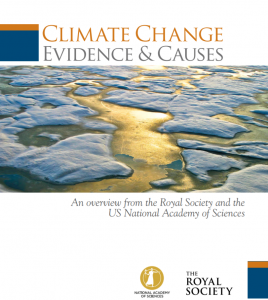There are a lot of sources you can find about climate change, but determining which sources are credible is essential tool. In the criteria for checking a source’s credibility, it is valuable to learn about the author or authors writing the information. Determining if they are experts in the field or just commentators could change the way you use the source. Also, understanding the purpose of the authors could give insight to the possibility of bias influence. Lastly, checking the origin of the information and the possible review process for publication can increase the credibility of the source.
With the evaluation of the 2014 report, “Climate Change Evidence and Causes”, published by the National Academy of Sciences and The Royal Society, I started by researching the authors of the report. Learning of the role the National Academy of Sciences (NAS), I found that the NAS is just one of the three academies operated by the National Research Council, the other two being the National Academy of Engineer and the National Academy of Medicine. These academies have examined climate change activities throughout displicines, encompassing the natural sciences, social sciences, health sciences, transportation, and the international realm (About Climate Change at the NASEM). Gathering members through election by peers for outstanding contributions to research, the NAS assembles the top scientific and technical experts of all fields. NAS was established in 1863 by President Lincoln with the purpose “to advise the nation on issues related to science and technology” (About Climate Change at the NASEM). It serves as a resource for the betterment of the United States. The NAS functions as a private, non-profit, nongovernmental institution in pursuit of advancing science, and bring rigorously peer reviewed finding to advise policy decision making and to inform the public.
Video on the Overview of the National Academies of Sciences, Engineering, and Medicine (NASEM)
The second author of this report is the Royal Society. Based in the UK, The Royal Society is a self-governing fellowship of many of the world’s most distinguished scientists. The members, like the NAS, derive from all areas of science, engineering and medicine. Including 1,600 of the world’s most eminent scientists, the members make up the UK’s national science academy. This range of expertise accessed in this report increases the source’s credibility. As addressed in the Royal Society’s founding charters, the Royal Society’s fundamental purpose is “to recognise, promote, and support excellence in science, and to encourage the development and use of science for the benefit of humanity” (Wolff Eric, Inez Fung, et. al.). These priorities promote the excellence of science, the importance of science, and international collaboration, demonstrating that the sources does not show a bias towards any political agenda (Mission and Priorities).
The “Climate Change Evidence and Causes” gives additional material for the information mention in the summary report including links to more detailed reports on specific issues. These links also include access to original research, which shows transparency. Through analyzing the webpage’s address, the .edu, .uk, or .gov indicate that all the sources come from either educational or governmental sites. Understanding the origin of the information in the summary report, the source has much greater credibility. The report is backed by scientific finds and the information can be traced back to its source. Furthermore, the fact that this report is compiled as an international collaboration by two reputable authors is strong indicator of the source’s creditability. There are both international writers and reviewers across disciplines. Reviewers also do not endorse the view of the authors. They are asked to only provide comments and suggestions, and they do not have the last word before the final draft is release as to not bias the report for an ulterior agenda. With an understanding of the thorough vetting process the report passes before publication, the “Climate Change Evidence and Causes” report, with its knowledgeable non-bias authors, and its transparency with research, is a credible source about climate change. As a useful tool for understanding the science and research, I would recommend this source to those wanting to find trustworthy, credible information to further their knowledge on climate change.

(Cover page of the “Climate Change Evidence and Causes” report)
Works Cited
“About Climate Change at the NASEM.” The National Academies of Sciences Engineering and Medicine, Climate Change at the National Academies of the Sciences, Engineering, and Medicine, 2017, nas-sites.org/americasclimatechoices/about-climate-change-at-the-nasem/.
“History of the Royal Society.” History of the Royal Society, Royal Society, 2017, royalsociety.org/about-us/history/#timeline.
“Mission and Priorities.” The Royal Society, Royal Society, 2017, royalsociety.org/about-us/mission-priorities/.
Wolff Eric, Inez Fung, and et. al. “Climate Change Evidence and Causes.” PDF file, 2014.
